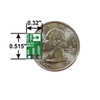Description
The U3V12Fx Range of step-up (boost) voltage regulators, enable you to generate output voltages higher than your input voltage, from as low as 2.5V. With a typical efficiency between 80% to 90%, the available output current is a function of the input voltage and output voltage, the input current can typically be as high as 1.4 A. This range of regulators, includes the choice of 5,9 and 12V output voltages, all at 1.4mA input current.
Step-up Voltage Regulator Features
- input voltage: 2.5 V – VOUT
- fixed 5/9/12V output with 4% accuracy
- 1.4 A switch allows for input currents up to 1.4 A
- 2mA typical no-load quiescent current integrated over-temperature shutoff
- small size: 0.515″ × 0.32″ × 0.1″ (13 × 8 × 3 mm)
Typical Efficiency and Output Current
The efficiency of a voltage regulator, defined as (Power out)/(Power in), is an important measure of its performance, especially when battery life or heat are concerned. As shown in the graphs below, this switching regulator typically has an efficiency of 80 to 90%.



The maximum achievable output current is approximately proportional to the ratio of the input voltage to the output voltage. If the input current exceeds the switch current limit (typically somewhere between 1.4 and 2 A), the output voltage will begin to drop. Additionally, the maximum output current can depend on other factors, including the ambient temperature, air flow, and heat sinking.
LC Voltage Spikes
When connecting voltage to electronic circuits, the initial rush of current can cause damaging voltage spikes that are much higher than the input voltage. You can suppress such spikes by soldering a 33μF or larger electrolytic capacitor close to the regulator between VIN and GND.
Step-up Voltage Regulator Documents
1 Review
-
Title of review 886
After one week 24/24 hours it works perfect ... :) no flames :)


















